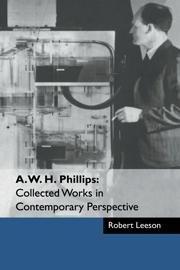Book contents
- Frontmatter
- Contents
- List of contributors
- Foreword by Arthur Brown
- Preface by Robert Leeson
- Part I Bill Phillips: Some Memories and Reflections
- Part II The Phillips Machine
- Part III Dynamic Stabilisation
- Part IV Econometrics
- 36 The Bill Phillips legacy of continuous time modelling and econometric model design
- 37 The published papers
- 38 The influence of A.W. Phillips on econometrics
- 39 An appreciation of A.W. Phillips
- 40 Some notes on the estimation of time-forms of reactions in interdependent dynamic systems
- 41 Cybernetics and the regulation of economic systems
- 42 The estimation of parameters in systems of stochastic differential equations
- 43 Estimation, regulation and prediction in interdependent dynamic systems
- 44 The Walras-Bowley Paper
- 45 Estimation of systems of difference equations with moving average disturbances
- 46 The estimation of continuous time models
- 47 Estimation in continuous time series models with autocorrelated disturbances
- 48 Efficient fitting of rational spectral density functions and transfer functions
- 49 The Lucas Critique: did Phillips make a comparable contribution?
- 50 Models for the control of economic fluctuations
- 51 Statistical estimation for the purpose of economic regulation
- 52 The last paper: a foreshadowing of the Lucas Critique?
- References
- Index of names
- Index of subjects
49 - The Lucas Critique: did Phillips make a comparable contribution?
Published online by Cambridge University Press: 04 May 2010
- Frontmatter
- Contents
- List of contributors
- Foreword by Arthur Brown
- Preface by Robert Leeson
- Part I Bill Phillips: Some Memories and Reflections
- Part II The Phillips Machine
- Part III Dynamic Stabilisation
- Part IV Econometrics
- 36 The Bill Phillips legacy of continuous time modelling and econometric model design
- 37 The published papers
- 38 The influence of A.W. Phillips on econometrics
- 39 An appreciation of A.W. Phillips
- 40 Some notes on the estimation of time-forms of reactions in interdependent dynamic systems
- 41 Cybernetics and the regulation of economic systems
- 42 The estimation of parameters in systems of stochastic differential equations
- 43 Estimation, regulation and prediction in interdependent dynamic systems
- 44 The Walras-Bowley Paper
- 45 Estimation of systems of difference equations with moving average disturbances
- 46 The estimation of continuous time models
- 47 Estimation in continuous time series models with autocorrelated disturbances
- 48 Efficient fitting of rational spectral density functions and transfer functions
- 49 The Lucas Critique: did Phillips make a comparable contribution?
- 50 Models for the control of economic fluctuations
- 51 Statistical estimation for the purpose of economic regulation
- 52 The last paper: a foreshadowing of the Lucas Critique?
- References
- Index of names
- Index of subjects
Summary
Econometric models may be used to provide assessment of and feedback to economic theory, and also for the interrelated purposes of policy and forecasting. Chapter 50, first published in 1968, makes a significant contribution to the latter purposes by pursuing a fundamental question about the feasibility of using aggregate econometric models for purposes of policy, forecasting and economic control. Phillips' question seems to have some relationship, indeed it appears in some ways to make a very similar point, to that which has become very well known in more recent years as the Lucas Critique.
Phillips presented his essay on underidentification in models of econ- omic control at a conference on mathematical modelling held in London in early July 1967. It was the last essay published during his lifetime and probably his least well-known contribution to economics. Lucas gave the paper containing his critique at a Carnegie-Rochester conference on pub- lic policy in April 1973, as part of a series of papers with the Phillips Curve as a major theme.
Phillips noted that governments carry out a degree of conscious control over their economies for the purposes of overcoming severe fluctuations in general economic activity and employment. He also noted that results of research in model building and econometric estimation were used in this process. His stated purposes in his paper were to ‘give an outline of this method and the way it would be used in economic control’, to ‘indi- cate an inherent limitation of the method’ and to ‘state the need for developing improved computational methods in order to facilitate the use of methods of learning or adaptive control’.
- Type
- Chapter
- Information
- A. W. H. Phillips: Collected Works in Contemporary Perspective , pp. 459 - 467Publisher: Cambridge University PressPrint publication year: 2000
- 2
- Cited by



